Disclosure: Meeple Mountain received a free copy of this product in exchange for an honest, unbiased review. This review is not intended to be an endorsement.
During my Gen Con meeting with the team at Czech Games Edition, our friend and marketing contact Nathan walked me through the upcoming game Kutná Hora: The City of Silver.
The cover art was…less than breathtaking. Still, Nathan’s brief dive into the rules and walkthrough of how turns worked had me excited. And I love economic games, particularly gems like Brick & Mortar, Power Grid, and Stockpile where prices can change from round to round.
Kutná Hora has a dynamic market at its core, so that was all I needed to get on board. Across plays at two and three players, only one question now remains:
Should I only play Kutná Hora with the full four-player count?
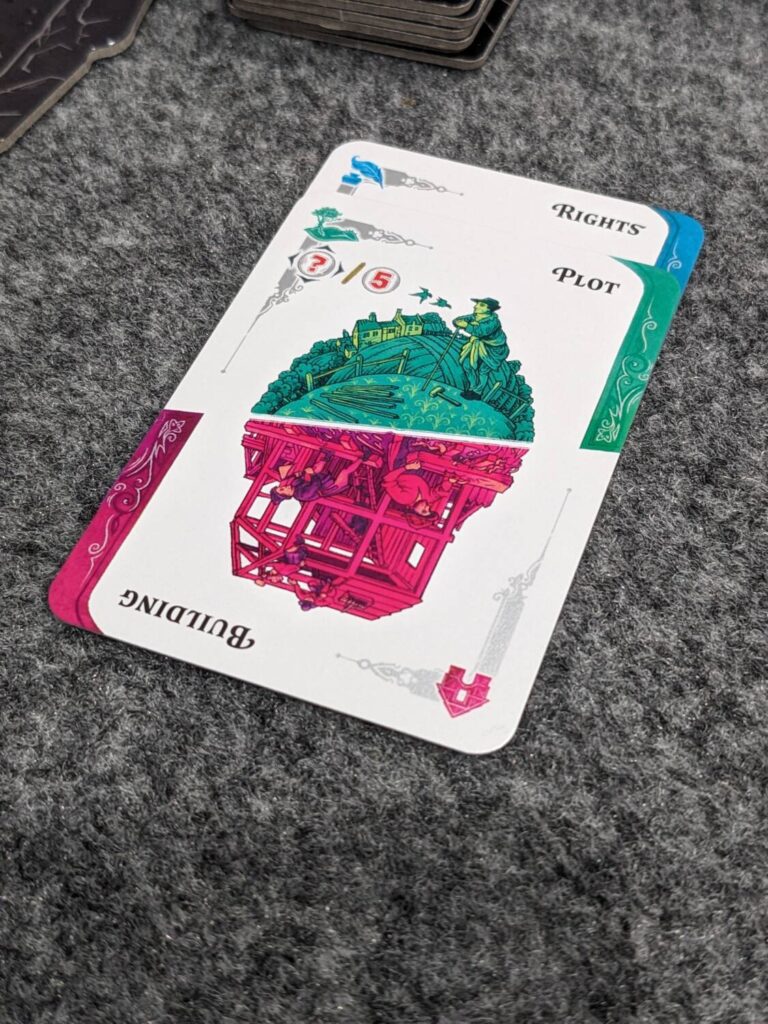
What’s Mine is Mine is That Part of the Mine
Kutná Hora is a 2-4 player area control, hand management, city building, and market manipulation game that plays in about 30 minutes per player. Set in the 13th and 14th century, players must build the real-life city of Kutná Hora (about 30 miles east of Prague) from scratch, including building up its industry and mining the silver and ore deposits located in and below the city. As leaders of a selection of three of the city’s six guilds, there’s also competition to construct guild buildings before your competition and gather income at just the right time to succeed.
Players will take five actions per round based on a hand of cards that never changes. That equates to 30 total actions in a two- or three-player game (25 actions in a four-player game). Each card offers a choice of one of two actions: gain income, build, take building tiles from a market (“Rights”), claim a building location on the map of the city (“Plot”), extend the mine, visit St. Barbara Cathedral to take a special action, or the Joker action, which can be any of the other six actions with a small penalty to that player’s reputation. That reputation track is important because it can equate to a handsome allotment of points at the end of the game if your rep is legit.
I really, really love how straightforward the actions are in Kutná Hora. Income is easy—based on the current production levels of the three guilds tracked on your player board, players spit out a number based on the current market price of each commodity. This is also the only way to get money in the game; there are no resources, so there are no extra bits to manage. Everything is built using wood, so checking the current wood price dictates most of the math you’ll have to do in a game.
The ease of action selection is bolstered by excellent player aids. In terms of the “big” publishers I consistently work with, CGE is the industry leader in this area. Even when I didn’t love the game (such as Starship Captains), CGE makes player aids that are world class. The double-sided aid for Kutná Hora is two, maybe three, icons away from serving as a manual for the entire game and answered almost every question players had during my plays.
Also, there aren’t a lot of combos here, making turns refreshingly short. Each action costs a card, and each card lists two options for an action. Players must take two actions on their first turn of a round, then two more actions on their second turn of a round. Final turns of a round consist of a single action, with a choice from a player’s remaining two cards in hand. Save for a couple of the St. Barbara bonus tile actions, there are no real surprises in a player’s turn. Everything here is really tight, in a way that I really enjoyed.
My plays have yielded something else—players don’t have to react with completely new information on each turn. Pre-planning is more than just possible, it is encouraged. Occasionally a pivot comes when the price of something such as wood drops by a Prague groschen or two on the turn prior to the new active player. (Groschen was the monetary unit of the time, apparently. In my house, we changed groschen to “Justin’s Iron Clays” as the monetary unit of the time.)
During setup, each player is given three guild tokens. These guilds determine which of the six guild building types are available to each player. In a two-player game, this means that each player has no competition between guilds—player one has access to all the buildings in each of their three guilds, and player two has access to the other three.
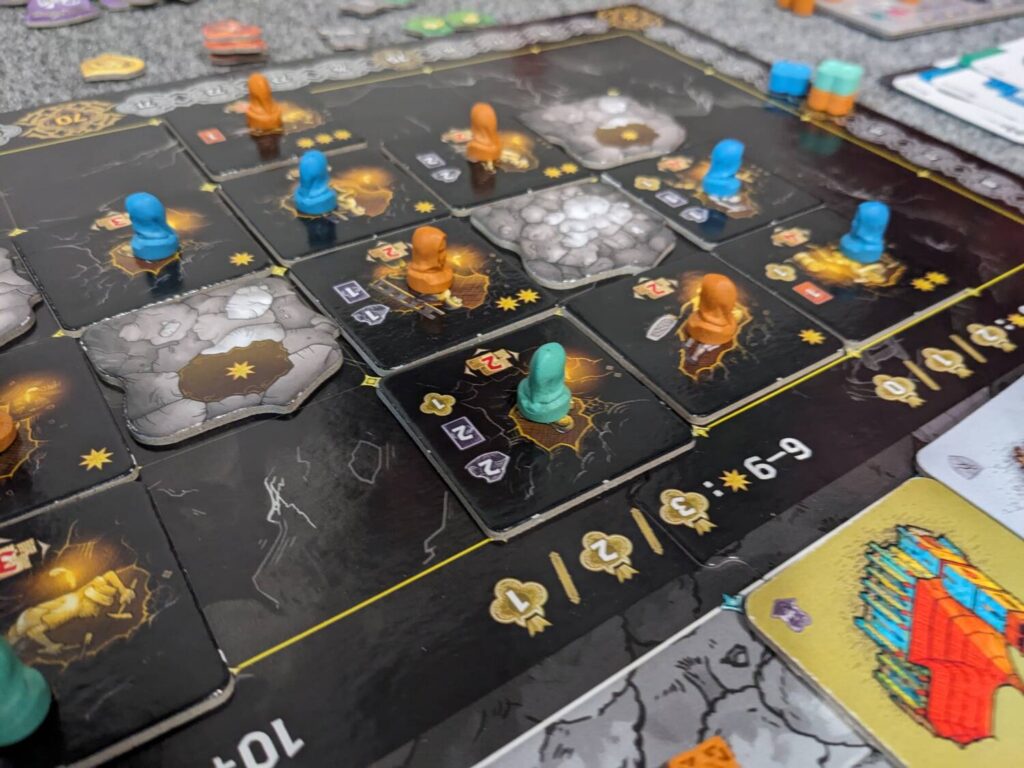
Which Leads Us to the Discussion About Player Count
At two players, Kutná Hora is average fare. The two-player variant requires the use of economic event cards to simulate a boost to the taxes that players must pay at the end of a round. It also includes the random removal of tiles or other game effects that may or may not really happen with more human players at the table.
I prefer more tension, interaction and competition for spots or resources in my games, and some of that is missing with two players here. I know some people in my gaming circles who would be more inclined to play Kutná Hora at two players, since it plays more like a dry (but colorful!) Euro. It’s just not as fun for me.
Even at three players, Kutná Hora begins to show its chops. Each player has only one guild (of the three in their possession) that is theirs and theirs alone. The other five guilds are in competition with at least one other player at all times. This means there is no guarantee that one player will have time to build all four of a guild’s structures…tension is a good thing.
That means with four players, every guild building is available to more than one player. That means competition for everything—building space on the maps, guild structures, mine areas—is much tighter.
Kutná Hora is really a four-player game.
An increased player count also makes the mine area juicier. Each of the four rows of the mine will be scored using an area majority mechanic. More stars equals more points for the faction that has the most miners in that row. The competition here is interesting because of the rules on where players can legally build (adjacent to a mine entrance, or any other built portion of the mine). Plus, one of the six guilds is the mining guild and building a mining guild building in the city means a reward of a free mining action.

A Couple Things Didn’t Work for Me
One part of the game didn’t work for me—the milestone mechanic. Using a system called Patricians, players have access to build not only guild structures but also public buildings. These public buildings don’t trigger bonuses on a player’s board. Instead, they aid in end-game scoring and in-game specials like a bump on the reputation track or victory points. They also add a Patrician token from the supply to a waiting area attached to one of the game’s four milestones.
Later, a player can add a Patrician during an Income action from the waiting area to cement a milestone that will score for all players at the end of the game. In my (admittedly limited) plays, milestones/Patricians turn into a big game of chicken. Who wants to pay 10 groschen to trigger the milestone that scores a point for every building adjacent to a public building, when they aren’t the only one who will take advantage of that condition?
I don’t love that adding the Patricians takes two separate steps, and I wish there was more variability to the milestones. (The same four milestones appear in every game.) Sure, expansion content blah blah blah, but this means Kutná Hora won’t look very different from game to game.
Another process I’m unsure about—the weight of the wood and ore resources. There are six guilds in the game: ore, silver, permits, wood, food, and beer. (It’s the early 1300s? Checks out.) Ore and wood are the two least valuable resources in the game, in terms of monetary value. Usually, building a wood building drives the price of wood down. In my plays, that puts a player who takes a turn right after this in a comfortable position—wood just got cheaper, so it’s a good time to build a building!
Wood feels a bit more consequential for almost everything in the game than, say, food or beer. This might be nothing, but it feels like something, and the players who have joined me for plays so far have agreed. I’m curious to see how that one pans out with additional plays.

Safe, Solid, Czech
Kutná Hora is good. “Solid,” said one player after a three-player game, and I’m inclined to agree with her. Kutná Hora didn’t knock my socks off, but I was really impressed with how tight everything feels. Turns are snappy, the teach is relatively easy, I’ve had a number of interesting turns (both as the active player and as an observer) in each game. Scoring is mostly manageable.
Mostly. The main wrinkle here is the end-game scoring for the buildings on the main map. Using a tag system tied to the tags on every other adjacent building and not the building you own, there is a period similar to the end of games like Brass: Lancashire where someone groans and then you manually score each individual building.
It’s not painful, but that part of the scoring is not elegant. The rest of it is pretty easy and scores usually wind up in the 55-75 point range, based on my plays.
Save for that bland box cover, the game looks great and the production features eco-friendly bits that feel good in the hand and look good on the table. The mix of colors—the black and gray main boards, mixed with the pop of color provided by the bright player pieces and art on the building tiles, make for a handsome table presence. I love how compact the board is, and although this is yet another CGE game without an insert, everything folds up real nice-like in the box.
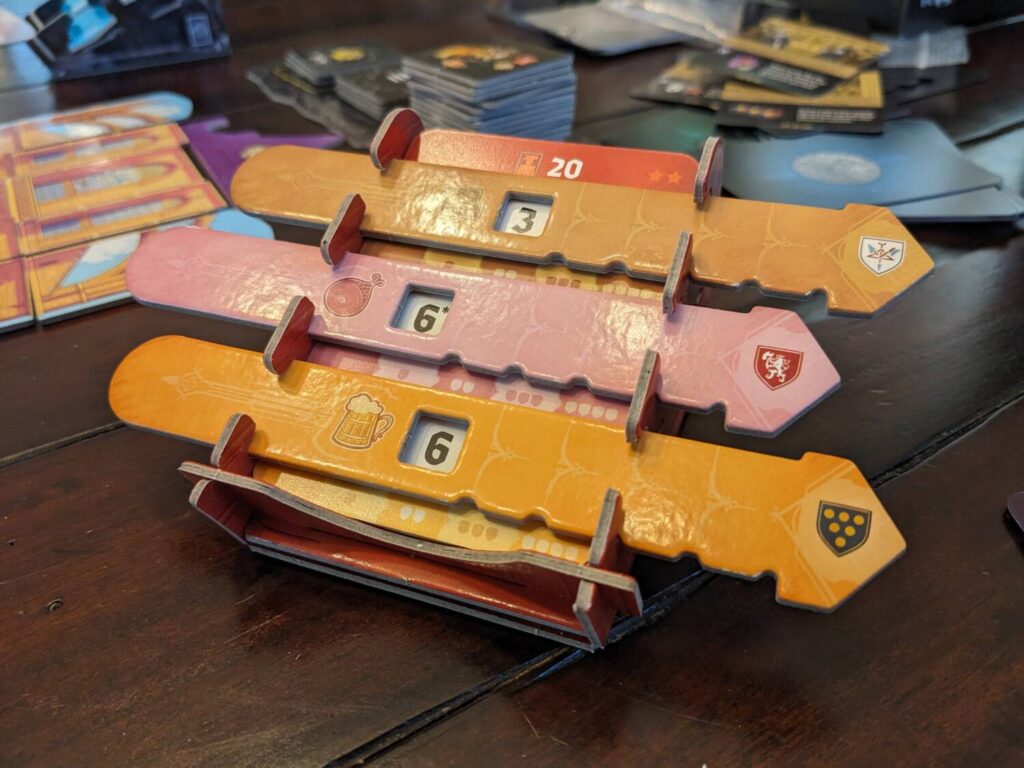
The propped-up cardboard trays that hold the market cards don’t tilt high enough. In a seat farther from these trays, it can be hard to see all of the current resource prices from across a table. Easily solved by putting stuff from the house underneath the back end, but still, I am surprised how flat these supposedly tilted trays appear.
Kutná Hora gets better with more players. I could see my fifth or sixth play being my last play without a boost to the variability. The guilds don’t change, the actions don’t change, the map doesn’t really change, the milestones don’t change. Technically, even the market doesn’t change, thanks to the market card system that occurs in rank order based on the city’s current population level.
In many ways, Kutná Hora feels like a overcorrection to the 2022 CGE release slate, particularly the risks involved with a title like Deal with the Devil, the four-player-only, hidden role game that was quite polarizing amongst gamers in my circles. Kutná Hora is simply a very solid Euro design. I thought Deal with the Devil was a miss, but I appreciated that CGE took a chance on something really different with that design. Hopefully, they will sprinkle chances like this on us from time to time.
As a game that offers tension and interesting decisions, Kutná Hora was a lot of fun. I will hang onto my copy in the hopes that expansion content comes down the pike soon. I’ll try to whip this out when I have a full player count, because games are better with more people at the table and cash is on the line!


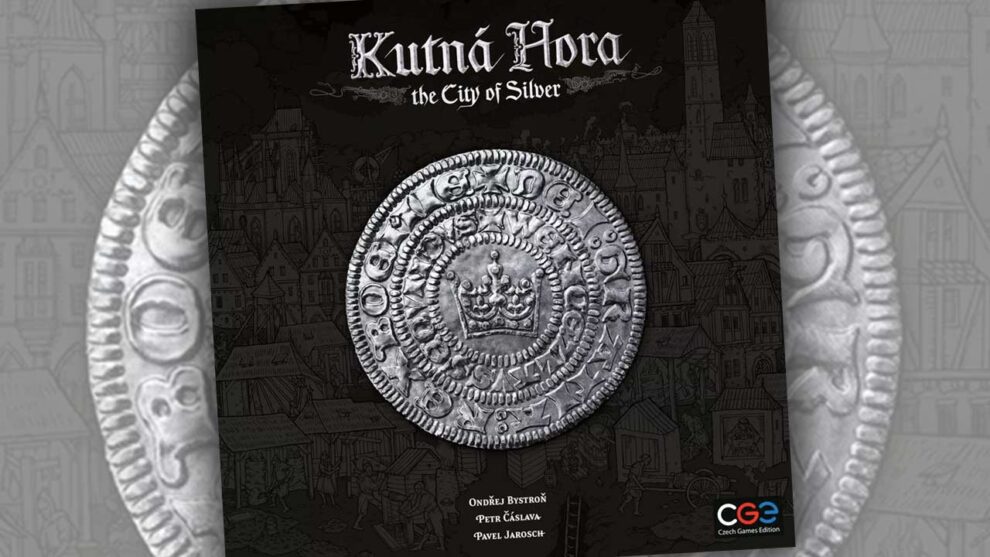

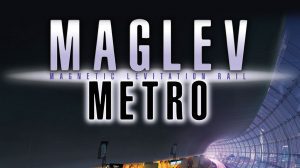







Great review, as always! Thanks!
This seems like the kind of game I would love. The problem is that most of the time, physical games are two-player affairs for me (my wife and I). I have moved to a place where I have more access to my long time friends — so perhaps this is something I can look into later, if those friends and I can start scheduling regular game time that does not involve Zoom and Board Game Arena.
Also, you bring up that this is a game that kind of needs an expansion or two to make it really shine. This is good to know! I have been burned with a few games that have felt flat for a while until an expansion that feels like it is essential to the game hits. I have been burned this way even with publishers that I have tremendous amounts of respect for.
These days, I tend to be more careful about what I add to my collection. So this one will have to wait. Definitely let us all know if the expansion this game needs comes along. I would love to give this game a shot!
Thanks, David…yeah, this is definitely best at higher player counts, so at two players, I would recommend other games over this one.